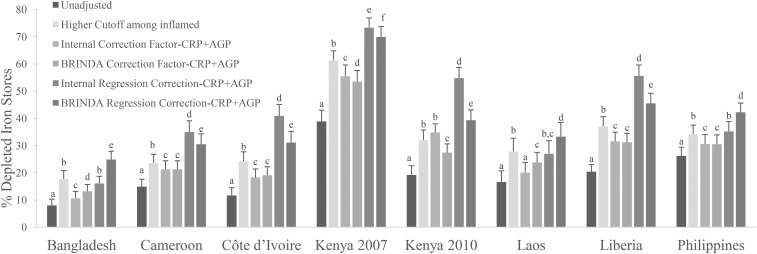FIGURE 4.
Estimated prevalence [% (95% CI)] of depleted iron stores with the use of different inflammation-adjustment approaches in preschool children: BRINDA project. Depleted iron stores were defined as a ferritin concentration <12 μg/L except in the higher-cutoff approach in which depleted iron stores were defined as a ferritin concentration <30 μg/L. Only surveys that measured both AGP and CRP are presented. Bars without a common lowercase letter within a given survey differ, P < 0.05 (adjusted by using Bonferroni correction). BRINDA correction factors were as follows—incubation phase: 0.68 (95% CI: 0.60, 0.79); early convalescence phase: 0.38 (95% CI: 0.30, 0.49); and late convalescence phase: 0.65 (95% CI: 0.58, 0.74) [QE (df = 28) = 515.9, P < 0.0001]. Internal regression correction and BRINDA regression correction reference values were as follows—CRP: −2.26 ln(mg/L) [QE (df = 10) = 439.9, P < 0.0001]; and AGP: −0.52 ln(g/L) [QE (df = 10) = 584.6, P < 0.0001]. BRINDA regression correction coefficients were as follows—ln CRP = 0.12 and ln AGP = 0.71 [QE (df = 21) = 644.8, P < 0.0001]. AGP, α-1-acid glycoprotein; BRINDA, Biomarkers Reflecting Inflammation and Nutritional Determinants of Anemia; CRP, C-reactive protein; -CRP+AGP, adjusting for C-reactive protein and α-1-acid glycoprotein.

